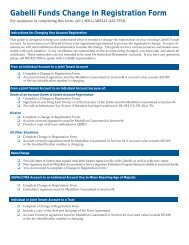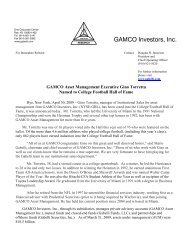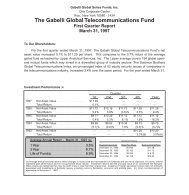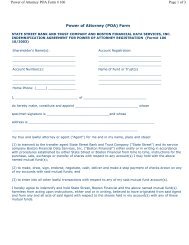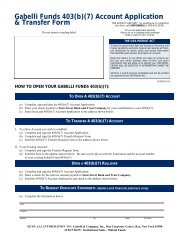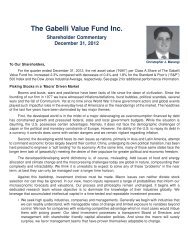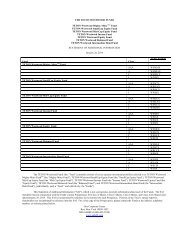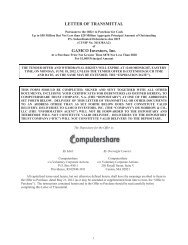FORM 10-K/A GAMCO Investors, Inc. - Gabelli
FORM 10-K/A GAMCO Investors, Inc. - Gabelli
FORM 10-K/A GAMCO Investors, Inc. - Gabelli
- No tags were found...
Create successful ePaper yourself
Turn your PDF publications into a flip-book with our unique Google optimized e-Paper software.
We also consolidated five other investment partnerships and two offshore funds in which we have a direct or indirect controlling financial interest as of and for the year ended<br />
December 31, 2006. These entities have been consolidated within our financial statements for the year ended December 31, 2006 and will continue to be consolidated in future<br />
periods as long as we continue to maintain a direct or indirect controlling financial interest. In addition to minor FIN 46R and EITF 04-5 adjustments to the consolidated statement<br />
of income and consolidated statement of cash flows for the year ended December 31, 2006 related to these entities, the consolidation of these entities also resulted in minor<br />
adjustments to our consolidated statement of financial condition at December 31, 2006. The consolidation of these entities on the consolidated statement of financial condition has<br />
increased assets by $17.5 million, liabilities by $3.2 million and minority interest by $14.3 million. Prior to consolidation of these entities, our investments in these entities were<br />
reflected within investments in partnerships and affiliates on the consolidated statement of financial condition and accounted for under the equity method.<br />
For the year ended December 31, 2006, the consolidation of these entities had no impact on net income but did result in (a) the elimination of revenues and expenses which are now<br />
intercompany transactions; (b) the recording of all the partnerships’ operating expenses of these entities including those pertaining to third-party interests; (c) the recording of all<br />
other income of these entities including those pertaining to third-party interests; (d) recording of income tax expense of these entities including those pertaining to third party interests<br />
and (e) the recording of minority interest which offsets the net amount of any of the partnerships’ revenues, operating expenses, other income and income taxes recorded in these<br />
respective line items which pertain to third-party interest in these entities. While this had no impact on net income, the consolidation of these entities does affect the classification of<br />
income between operating and other income.<br />
Goodwill<br />
Prior to the issuance of Statement of Financial Accounting Standards (“SFAS”) No. 142, goodwill and other long-lived intangible assets were amortized each year. The adoption<br />
of SFAS No. 142 at the beginning of 2002 eliminated the amortization of these assets and established requirements for having them tested for impairment at least annually. During<br />
the first quarter of 2005, AUM for our fixed income business decreased approximately 42% from the beginning of the year, triggering under our accounting policies the need to<br />
reassess goodwill for this previously 80% owned subsidiary. Using a present value cash flow method, we reassessed goodwill for this entity and determined that the value of the<br />
entity no longer justified the amount of goodwill. Accordingly, we recorded a charge of $1.1 million for the impairment of goodwill which represented the entire amount of goodwill<br />
for this entity during 2005.<br />
At November 30, 2005 and November 30, 2006, management conducted its annual assessments and assessed the recoverability of goodwill and determined that there was no<br />
further impairment of the remaining goodwill on GBL’s consolidated financial statements. In assessing the recoverability of goodwill, projections regarding estimated future cash<br />
flows and other factors are made to determine the fair value of the respective assets. If these estimates or related projections change in the future, it may result in an impairment<br />
charge for these assets to income.<br />
<strong>Inc</strong>ome Taxes<br />
In the ordinary course of business, we prepare a number of tax returns, which are regularly audited by federal, state and foreign tax authorities. The inherent complications in the<br />
various tax codes often create the need for subjective judgments in applying its provisions. While management believes that tax positions taken comply with tax law and are both<br />
reasonable and supported by the facts and circumstances of the situation, upon audit additional taxes may be assessed. While assessments may be proposed in the future, both the<br />
extent of and potential impact on financial results cannot be determined at this time.<br />
Stock Based Compensation<br />
Effective January 1, 2003, we use a fair value based method of accounting for stock-based compensation provided to our employees in accordance with SFAS No. 123,<br />
“Accounting for Stock Based Compensation.” The estimated fair value of option awards is determined using the Black Scholes option-pricing model. This sophisticated model<br />
utilizes a number of assumptions in arriving at its results, including the estimated life of the option, the risk free interest rate at the date of grant and the volatility of the underlying<br />
common stock. There may be other factors, which have not been considered, which may have an effect on the value of the options as well. The effects of changing any of the<br />
assumptions or factors employed by the Black Scholes model may result in a significantly different valuation for the options. We adopted Statement 123 (R), “Share-Based<br />
Payment” (“Statement 123 (R)”) on January 1, 2005. In light of our modified prospective adoption of the fair value recognition provisions of Statement 123 (R) for all grants of<br />
employee stock options, the adoption of Statement 123 (R) did not have a material impact on our consolidated financial statements.<br />
62




